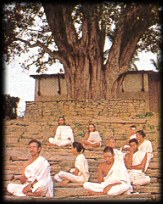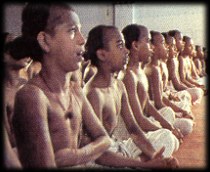  |  |
|
 Education in India has always been regarded as one of the basic inputs in human resource development. In the ancient days, the Gurukul system of education was prevalent. The teacher was the Guru and the disciple was the Sishya. The disciples lived in the Guru's aashram during the course of their training and in turn offered their services to the ashram. This period of learning of, about 12 years, was considered as a great sacrifice or a penance. The Guru identified the capability of his Sishya and accordingly imparted knowledge. The sishyas learnt amidst the natural surroundings of the ashram, in open air, in close contact with nature.
Education in India has always been regarded as one of the basic inputs in human resource development. In the ancient days, the Gurukul system of education was prevalent. The teacher was the Guru and the disciple was the Sishya. The disciples lived in the Guru's aashram during the course of their training and in turn offered their services to the ashram. This period of learning of, about 12 years, was considered as a great sacrifice or a penance. The Guru identified the capability of his Sishya and accordingly imparted knowledge. The sishyas learnt amidst the natural surroundings of the ashram, in open air, in close contact with nature.
One of the most ancient universities of India is in Nalanda near Patna. Founded in the 5th Century AD, this great seat of learning flourished until the 12th century AD. The founder of Buddhism, Gautam Buddha and Jainism, Parsvanath Mahavir are believed to have visited Nalanda. The Chinese chronicler Huen Tsang spent many years here both as a student and as a teacher. Nagarjuna, the Buddhist Mahayana philosopher, Dinnaga, the logician and Dharmapala, the Brahmin scholar taught here. At one point of time about 2000 teachers and 10,000 students crowded the portals of Nalanda University.
|
| About India | Arts | Cuisine | Fairs | Festivals | Neighbours | Society | Religions |
| Site Map | Disclaimer | About Us | Write To Us |

 The Kings sent their Princes to Gurus for training on the art of using weaponry, vedas, music, art and physical forms of exercising & defence. At the end of their training, the disciples thanked their Gurus with a gift in the form of a gurudakshina - which literally means "offerings to the Guru".
The Kings sent their Princes to Gurus for training on the art of using weaponry, vedas, music, art and physical forms of exercising & defence. At the end of their training, the disciples thanked their Gurus with a gift in the form of a gurudakshina - which literally means "offerings to the Guru".